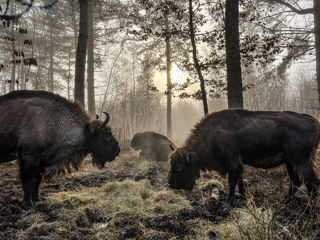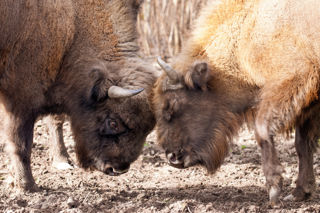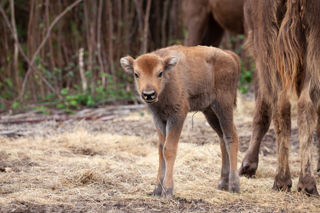
Bison blog
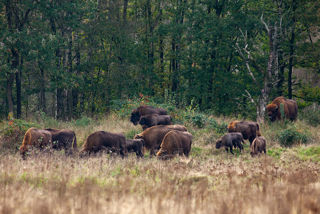
Nov 2024
The herd is growing, and currently they are roaming within 50 hectares of the woodland, with a further 150 hectares set aside for their use.
Dangerous wild animal legislation means that the herd cannot share the same space as the public and with footpaths crisscrossing the blean complex this poses a challenge for the Wilder Blean team. The answer – bison bridges - which connect the landscape whilst also giving people the opportunity to see the herd as they make their way through the woodland.
Paul Hadaway, Director of Conservation at Kent Wildlife Trust said: “We did not want to re-route the public rights of way. Community engagement is one of the fundamental objectives of the project, so taking away the public’s opportunity to see the bison was not an option. The bridges provide a natural way for the bison to roam whilst also giving people viewing opportunities.”
The team also continues to work with MPs and other government bodies like Defra to advocate for change in legislation and make the Dangerous Wild Animal Act fit for purpose and not a barrier to wilding initiatives.
It is hoped that others can follow the footsteps of the Wilder Blean Project and connect our landscapes for wildlife, using nature-based solutions to create a better future for our planet.
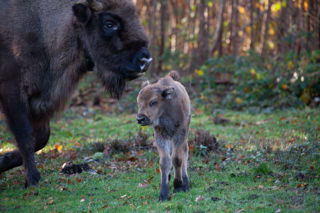
Dec 2023
In December 2023, in what can aptly be described as “the best Christmas present,” a new bison calf was born. This is the second calf and a significant milestone in the successful journey of our Blean bison project.
The latest arrival and sixth member of the herd is the first to have been conceived and born in the woodland from the specially selected founding herd.
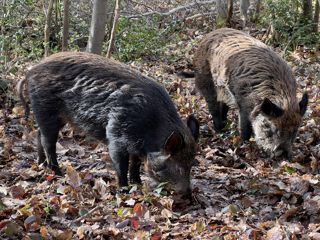
Mar 2023
Throughout the winter of 2022 the herd began to bond and explore more of the woodland. In March, the woodland was ready to receive the final assemblage of wilder grazing animals with the release of Iron-Age pigs, Longhorn cattle and Exmoor ponies.
Unlike the bison, these animals are not constrained by legislation and roam within the public areas of West Blean and Thornden Woods, often delighting visitors with their presence. They have been chosen for their ability to transform the woodland as a nature-based solution to woodland management, with the pigs rootling and churning up soil which encourages plants to grow and the cattle and ponies eating the thicker vegetation.
In time, some of the ponies will be introduced into the bison area and the pigs will roam between the wider woodland and the 200 hectares in which the bison live.
Director of Conservation for Kent Wildlife Trust Paul Hadaway said: “The impacts of the grazers will be closely observed as part of one of the largest monitoring programmes of its kind in the UK. With three treatment areas, research will establish how the bison impact the woodland differently to the other grazing areas.
“The first treatment area comprises of bison, ponies and pigs, the second longhorn cattle, ponies and pigs and the third will continue to be managed by traditional methods of coppicing and felling. The research results will be published at intervals throughout the monitoring programme.”
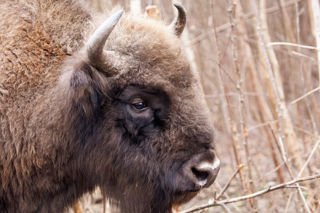
Dec 2022
On 23rd December 2022, in torrential rain and in stark contrast to July when the Blean bison team struggled to keep cool in the sweltering heat, the herd was about to become complete.
The bull, from Germany, had finally made his way to Kent. His arrival was testament to hours of work by staff at Wildwood Trust, who had navigated a series of complex import challenges in a post-Brexit situation, to get the bison across the channel. The bull is genetically important with a bloodline that could be traced to the founding 12 bison herd that brought the species back from the brink of extinction shortly after the first world war.
However, the biggest challenge was yet to face the team, as freezing temperatures and a deluge of rain were discouraging the bull from leaving the warm refuge of the trailer. However, thanks to the experience of the Director of Zoological Operations for Wildwood Trust, Mark Habben, the introduction proceeded. Mark said: “Bison live as a herd and we knew that if the bull knew the herd was nearby, he would be keen to join them so the rangers used their skills to encourage the females up to the corral area, where the bull was enjoying the warmth of the trailer, and within moments of catching their scent in the air he was on his feet. The bison took a moment to get to know each other before calmly making their way back into the woodland.”
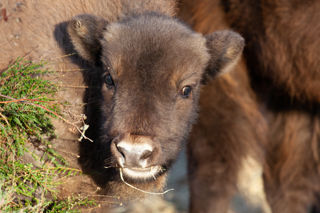
Sep 2022
As the herd became accustomed to the woodland and summer faded into autumn, a surprise awaited bison rangers. Under the cover of darkness, in early September, one of the young females had slipped into dense woodland and had become detached from the herd.
The rangers tracked the lone bison to a quiet corner of the woodland to conduct a welfare check. They saw her feeding off the vegetation, but did a double-take as a little head popped out from behind her.
The question the rangers get asked is '‘How did you not know?" Bison conceal their pregnancies very well as a defense mechanism to prevent being targeted by predators. This bison had also given birth well outside of the breeding season. Despite all this, it was a historic moment. The first wild bison calf born in the UK!
The moment was celebrated by the nation, even capturing the attention of Hollywood legend Leonardo DiCaprio who posted the news on his social media channels.
Ranger Don even managed to capture some stunning photographs and videos of the calf and her mum which were shared globally by news outlets, he said: “This is an incredibly important moment, this bison will only ever know West Blean and Thornden Woods; she will learn where all of the best places are to feed, drink and dust-bathe – she is the future of conservation in the UK.”
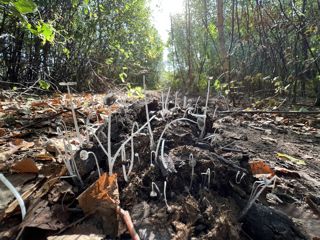
Aug 2022
The herd immediately set to work in the woods, and within weeks, they had trampled brambles, thrashed and stomped the Rhododendron, and de-barked willow trees. Corridors began to open through the woodland and light started to reach the forest floor.
Bison ranger Donovan Wright photographed fungi growing from the bison’s dung and was excited to see dung beetle larvae in the droppings, he said: “Whilst we anticipated changes, no-one expected to see them so quickly. Within weeks we had dung beetle larvae in the bison’s droppings – how the dung beetles got the memo that there were bison in the Blean that quickly, I will never know.”
Within six weeks, another potentially exciting discovery was made by the Blean bison team following a phone call with the scientists analysing the bison’s dung. Donovan Wright continued: “We had a phone call from the lab, asking if bison self-medicate.
When the matriarch arrived, she had a number of parasites in her droppings. However, after a few weeks, that number dropped significantly. Tom and I went back through our notes and we had both recorded that we had observed the matriarch eating Yew, which contains toxins, so perhaps she was self-medicating to rid herself of the parasites.”
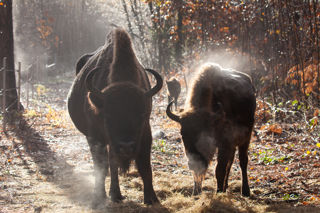
Jul 2022
The founding herd consisted of an 18-year-old matriarch from Scotland and two younger females from Ireland. The anticipated arrival of a bull from Germany was delayed due to post-Brexit animal import complications, meaning that the females began to explore the woodland as a trio.
Within hours of the release, changes in the landscape began to take place, right in front of the Director of Wildwood Trust, Paul Whitfield as he observed the matriarch making a beeline for Rhododendron. He said: “The matriarch dived into a thicket of Rhododendron, which is an invasive species and circled her head in a figure of eight motion. She emerged from the bushes with a crown of the plant attached to her horns.
“It was an exceptionally hot day, and the animals were being pestered by flies. After discussion with the Bison Rangers, we concluded she may have been attempting to use the oils in the plant as an insect repellent, which if correct, is fascinating.”

